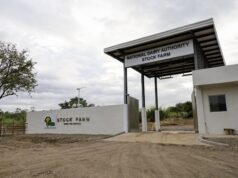HARVEST. Agriculture Secretary William Dar joins the farmers in harvesting edamame. Contributed Photo
CABANATUAN CITY – Edamame, the popular young soybean from Japan has finally, if quietly, come to the Philippines, readily becoming one cash crop for local farmers.
Tuesday, edamame broke into the local agricultural scene with no less than Agriculture Secretary William Dar leading the first harvest ever of the soybean in a 20-hectare farm joint project of Top Shelf Corp. and multiple North Luzon farmers cooperatives in Barrio Talipapa here.
“This is sustainable with higher value in terms of income they give to the farmers. And we are in full support to this endeavour because farmers will be given the chance to get rich,” Dar enthused. The edamame initiative was in response to his call for land and farm consolidation and prioritizing agriculture as an industry.
Resistant to hot weather, edamame can be harvested within 62 days, and is therefore a sustainable cash crop for Filipino farmers, Dar said.
Japanese for “beans on a branch” and often found in East Asian cuisine, edamame is sold, and consumed, both in the pod and hulled.
Dar said growing edamame is advisable and necessary in crop rotation: “During dry season, after the rice crop, farmers should diversify in growing high value crops like edamame.”
The agriculture secretary is profuse in his thanks to Top Shelf Corp. led by Raphael Pelayo, Elaine Timbol, and Jeff Fernandez; the North Luzon farmers coops through the guidance of former Candaba Mayor Jerry Pelayo, now a member of DA Technical Advisory Group that worked in partnership with and Golden Beans and Grains Producers Cooperative in coordination with City Mayor Myca Elizabeth R. Vergara in realizing edamame production here.
“They are considered as innovators in promoting crop diversifi cation using high value crops. The harvested edamame, a high value commercial crop is now being exported to Japan. We are taking the lead and supporting in a big way the crop diversification program,” he said.
Dar stressed that with the growing of edamame here, Cabanatuan City will be put to the map of global trading market.
“Edamame has high yield potentials with high income. When exported to Japan, the farmers and their partners will really benefit from it,” the secretary said.
Dar also gave a message to Japanese partners that Filipino farmers can grow the kind of food they would like to have from the Philippines.
“We have all the types of environment and kinds of soil that we can use to really grow the export items like edamame,” he furthered.
Pelayo said the demand for edamame in Japan is so big that they have started planning to expand and utilize 500 to 700 hectares of farm land in Central Luzon, Ilocos, and Cagayan for the crop.
“This is an alternative high value crop for Filipino farmers. It is adaptable in the soil and climate of our country. We have the purchase order from Japan because our produce here is better than that in Taiwan,” Pelayo explained.
Pelayo added that this will be a big help for the Filipino farmers and in the future, they will invite the government of Japan and show them the process from planting, propagation, to harvesting.
Edamame beans are whole, immature soybeans, sometimes referred to as vegetable- type soybeans. They are green and diff er in color from regular soybeans, which are typically light brown, tan or beige.





